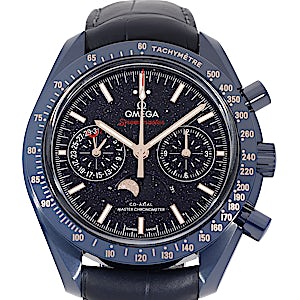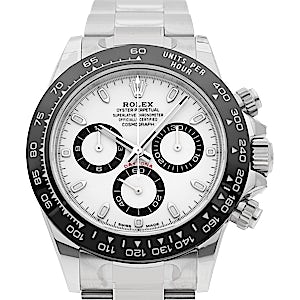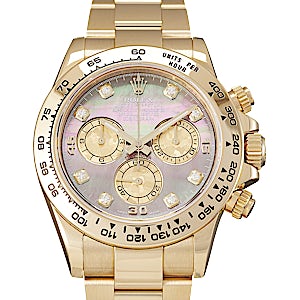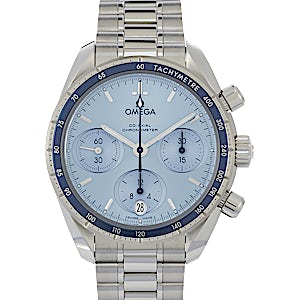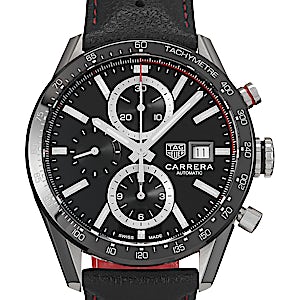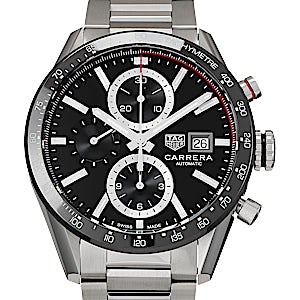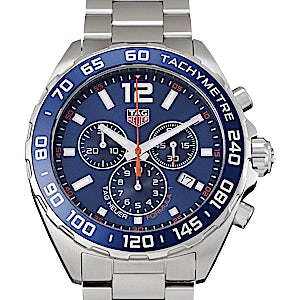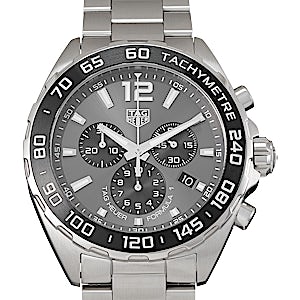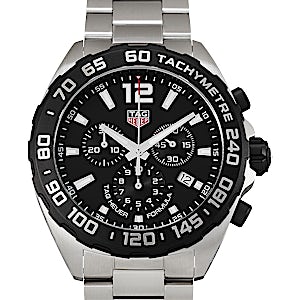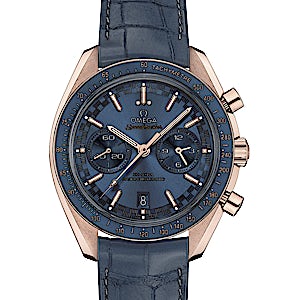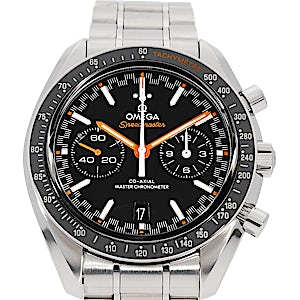Tachymeter Watches
Watches with tachymeter – ideal for every adventure
A tachymeter scale offers so much more than a sporty presentation. Tachymeter watches can be used to measure average line speeds. The physical formula for this: "Speed = distance/time". Timepieces with a tachymeter function are suitable as luxurious statement watches as well as practical instruments for determining speed.
Every second counts – watches with tachymeter
Watches with tachymeter functions are used to estimate the average speed of an object or process using a fixed and known route length as a starting point. Many wristwatches with a stop function are also equipped with a tachymeter. Tachymeters meet a wide range of applications. Some are practically second nature to us today, such as using the tachymeter as a computing instrument for the hourly kilometre display. These practical speedometers were primarily used to measure speed in races such as car or horse races. In addition, pilot's watches are equipped with a tachymeter to calculate flight speed. Tachymeters are also useful companions in shipping. The so-called nurse or doctor watch is a highly specialised type of tachymeter watch. Thanks to the tachymeter scale, it is possible to measure the pulse of each patient and make initial health assessments quickly and accurately.
The top tachymeter watches at CHRONEXT
1. Omega Speedmaster
2. Rolex Daytona
3. Breitling Bentley Mulliner Tourbillon
4. Sinn Chronograph Tachymeter
5. TAG Heuer Carrera Chronograph Tachymeter Racing
Omega Speedmaster
Also known as the Moonwatch, the Omega Speedmaster on Buzz Aldrin's wrist was the first watch on the moon in 1969. In Apollo 13, it prevented disaster. The Omega Speedmaster embodies the brand's endless commitment to precision, perfection and timeless style. Launched in 1957, the Omega Speedmaster is invariably valued for its stability, ease of use and good legibility.
Rolex Daytona
The legendary Rolex Daytona stands for ambition and success. Its elegant accents present the watch as a stylish accessory as well as a speedometer. Designed for motorsport, its name comes from the popular 24-hour race at Daytona in Florida. The 4130 caliber literally has “petrol in the blood”. It was specially developed by Rolex as a mechanical high-performance manufacture movement for chronographs.
Breitling Bentley Mulliner Tourbillon
The Breitling Bentley Mulliner Tourbillon is a truly upscale watch that is named for the Bentley luxury automobile. The top-class timepiece impresses watch enthusiasts with its tourbillon, which is a pinnacle of watchmaking. The exclusive Bentley Mulliner Tourbillon is only produced a few times a year; privileged customers have various choices that enable them to create their own Bentley Mulliner Tourbillon. A tourbillon chronograph movement with manual winding makes this masterpiece tick. In addition, the iconic wristwatch now comes with a new 30-second chronograph and a hand calendar.
Sinn Chronograph Tachymeter
The Sinn Chronograph Tachymeter is a masterpiece of retro style. The most striking feature is the matt black dial with the triple tachymeter spiral. This enables speed measurements from 20 km / h to 300 km / h. This exceptional range enables the tachymeter to also be used to measure speed on slower routes such as classic car races. In addition, the sand-coloured luminescent material adds colourful accents and a dash of vintage style to the hands and indices of this tachymeter.
TAG Heuer Carrera Chronograph Tachymeter Racing
The Carrera Chronograph Tachymeter Racing watch has been on the market since 2005. It is considered a highly functional and masculine timepiece. With its automatic 16 caliber, it is considered one of the indispensable watches with tachymeter details for speed lovers and motorsport fans.
The legendary wristwatch is sporty: black dial, bevelled indices and bright red hands. The placement of the tachymeter scale on the bezel guarantees particularly good readability.
Functions of a tachymeter watch
The tachymeter function is used to measure speed. This is possible with the help of the second hand, which also relates to other functions of a chronograph. Neither a stopwatch function nor a rotating bezel is necessary to read the tachymeter scale – which is why tachymeter scales are occasionally printed on the dial. A tachymeter scale should not be confused with a slide rule bezel. Tachymeter scales enable users to determine units per hour by measuring the time interval between two units. In order to be recognised as a tachymeter watch, the scales are therefore marked with "units per hour", such as on the Rolex Daytona. Other timepieces like the Omega Speedmaster use the name "Tachymetre".
The tachymeter function – simple physics
The function of the tachymeter scale is based on a simple physical formula that gives the sum of the part of the hour that has passed since the second hand reached 12. Thus, the scale of watches with tachymeter is “per hour”. If the reciprocal value to be read is multiplied by an arbitrary length, the change in this quantity is read as per time, such as kilometres per hour. Due to the assumption that the process to be measured takes at least 15 seconds, but a maximum of 75 seconds, there is a slightly twisted, initially confusing scale on tachymeter watches. This is because a significant measurement error can occur if the measurement times are too short and the tachymeter accuracy suffers considerably.
Variable tachymeters with a circular slide rule are also used, such as with the Breitling Bentley Mulliner Tourbillon from 2005. Stopwatch and tachymeter watches impress users with their precise accuracy - the central chronograph hand rotates one half-minute and the measurements are accurate to a sixth of a second.
Successful history of the tachymeter watch
The term tachymeter from ancient Greek is a combination of "fast and" scale "and is understood in the watch industry as a scale on the dials or bezels of chronographs. Watches with a tachymeter such as those at CHRONEXT have long been in use as a tool for sports drivers. These watches are commonly known as men's drivers. The first automobiles in the late 19th century moved slowly and were not equipped with tachymeters. If you wanted to know your speed in kilometres per hour, you could use a wristwatch with a tachymeter scale.
Years later, private vehicles became more modern and more technically sophisticated: The speed of cars and interest in speed measurement increased significantly. In addition to the automotive industry, which began installing tachymeters in vehicles as standard, numerous watch manufacturers also began to equip many of their timepieces with the special tachymeter function. In racing, these practical tachymeters are traditionally used in classic car rallies.
